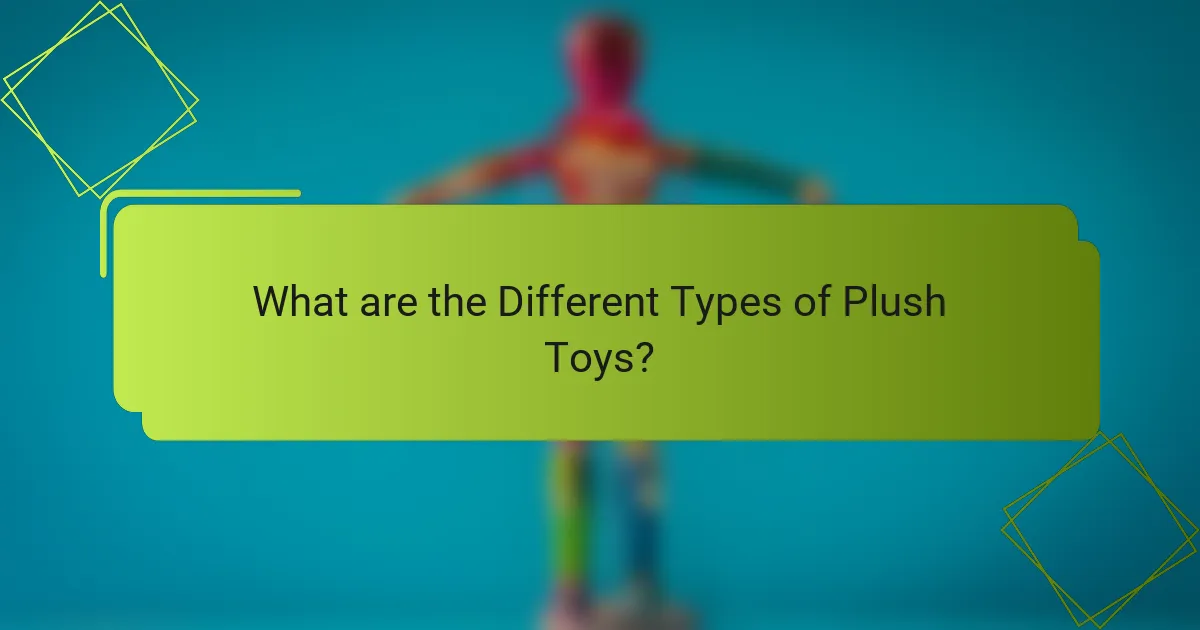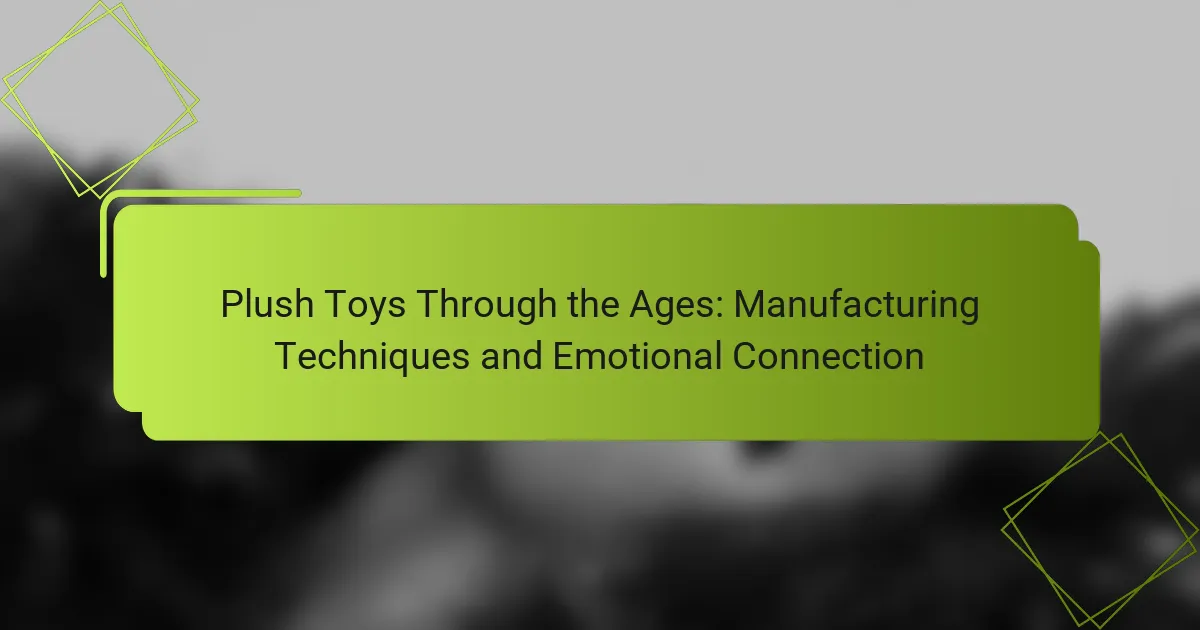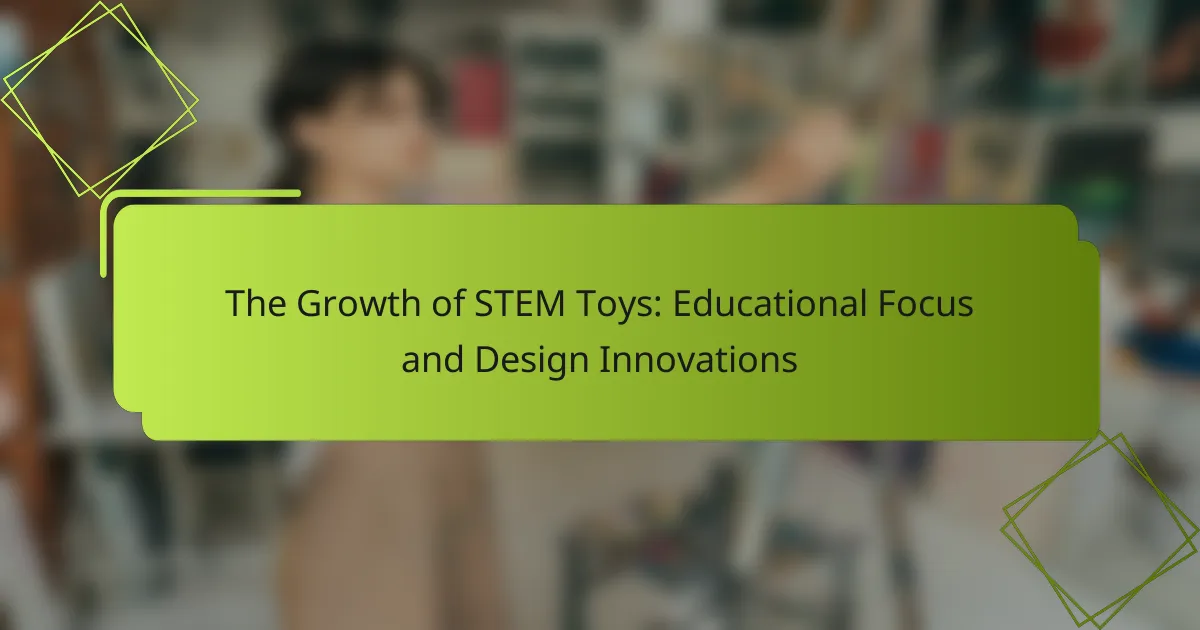
What are Plush Toys and Their Historical Significance?
Plush toys are soft, stuffed animals or figures made from fabric and filled with materials like cotton or polyester. They have been popular since the late 19th century. The first mass-produced plush toy was the teddy bear, created in 1902. This toy was inspired by a political cartoon featuring President Theodore Roosevelt. Plush toys serve as comfort objects for children and have emotional significance in many cultures. They often symbolize companionship and security. Their historical significance includes the rise of toy manufacturing and the development of childhood psychology. Plush toys have evolved into collectibles and are cherished by people of all ages.
How have plush toys evolved over time?
Plush toys have evolved significantly since their inception in the late 19th century. Initially, they were handcrafted from materials like felt and cotton. The introduction of synthetic materials in the mid-20th century allowed for greater durability and variety. In the 1980s, plush toys began to incorporate sound and movement features, enhancing interactivity. The rise of licensed characters from movies and television in the 1990s further popularized plush toys. Today, advancements in technology enable the creation of smart plush toys that can connect to apps and respond to users. This evolution reflects changing consumer preferences and technological advancements in manufacturing.
What were the earliest forms of plush toys?
The earliest forms of plush toys were simple stuffed animals made from fabric and filled with materials like straw or sawdust. These toys date back to the late 19th century. Early examples include handmade dolls and animals, often crafted by mothers for their children. The first mass-produced plush toys emerged in Germany during the 1900s. Notably, the Steiff company introduced the first teddy bear in 1902. These toys quickly gained popularity and became symbols of childhood comfort. Their soft texture and huggable forms contributed to emotional connections with children.
How did historical events influence plush toy design?
Historical events significantly influenced plush toy design by shaping cultural values and consumer preferences. For instance, World War I led to the creation of teddy bears as symbols of comfort for children during turbulent times. The Great Depression prompted manufacturers to produce more affordable toys, leading to simpler designs. Post-World War II, the rise of consumerism and the baby boom resulted in an increased demand for diverse plush toys. The introduction of synthetic materials in the 1960s allowed for more vibrant colors and innovative designs. Additionally, significant cultural movements, like the environmental movement in the 1970s, encouraged the use of eco-friendly materials in plush toy production. Each of these historical contexts directly impacted the aesthetics, materials, and marketing strategies associated with plush toys.
Why do people form emotional connections with plush toys?
People form emotional connections with plush toys due to their comforting and familiar nature. Plush toys often represent security and companionship, particularly in childhood. They can evoke feelings of nostalgia and warmth, linking to positive memories. Research indicates that such attachments can provide emotional support and reduce anxiety. For many, these toys serve as confidants, enhancing their sense of belonging. Studies show that children often attribute human-like qualities to plush toys, further deepening the bond. This phenomenon is rooted in developmental psychology, where attachment theory explains the importance of comfort objects. Thus, plush toys fulfill both emotional and psychological needs for many individuals.
What psychological effects do plush toys have on individuals?
Plush toys can provide comfort and emotional support to individuals. They often serve as transitional objects, helping children cope with separation anxiety. Studies indicate that hugging a plush toy can release oxytocin, promoting feelings of safety and trust. Adults may also find solace in plush toys, using them for stress relief or nostalgia. Research shows that interacting with plush toys can decrease feelings of loneliness. The tactile nature of these toys can evoke positive memories and enhance emotional well-being. Overall, plush toys play a significant role in emotional regulation across various age groups.
How do plush toys serve as comfort objects?
Plush toys serve as comfort objects by providing emotional support and a sense of security. They are often associated with childhood memories and can evoke feelings of nostalgia. Plush toys are soft and huggable, which can offer tactile comfort. Research indicates that children often use these toys to cope with anxiety and stress. A study published in the journal “Child Development” found that children with comfort objects displayed lower levels of distress in unfamiliar situations. Plush toys also serve as transitional objects, helping children navigate changes in their environment. Their presence can facilitate emotional regulation and serve as a source of companionship. Overall, plush toys play a significant role in emotional well-being.
What are the key manufacturing techniques for plush toys?
The key manufacturing techniques for plush toys include cutting, sewing, stuffing, and finishing. Cutting involves creating patterns from fabric to form the toy’s shape. Sewing is the process of stitching the cut pieces together. Stuffing fills the sewn fabric with materials like polyester fiber or foam. Finishing includes adding details such as eyes, noses, and other embellishments. Each technique is crucial for producing high-quality plush toys. The use of advanced sewing machines and automated cutting tools has improved efficiency in production. Quality control measures ensure that plush toys meet safety standards. These techniques have evolved over time, adapting to consumer preferences and technological advancements.
How has technology changed the manufacturing of plush toys?
Technology has significantly changed the manufacturing of plush toys. Automation has streamlined production processes, reducing labor costs and increasing efficiency. Computer-aided design (CAD) allows for precise patterns and designs, enhancing creativity and accuracy. Advanced materials, such as hypoallergenic fabrics, improve safety and comfort for children. Digital printing technology enables intricate designs and vibrant colors on plush surfaces. Robotics assist in sewing and stuffing, ensuring consistency in quality. Additionally, 3D printing offers the potential for customized plush toys, catering to individual preferences. These technological advancements have transformed the industry, making plush toys more accessible and appealing.
What materials are commonly used in plush toy production?
Common materials used in plush toy production include polyester, cotton, and acrylic. Polyester is widely favored for its durability and softness. Cotton offers a natural feel and is often used for stuffing. Acrylic fibers are known for their vibrant colors and resilience. Additionally, foam and pellets are commonly used as stuffing materials. These materials contribute to the plush texture and overall quality of the toys. The choice of materials impacts the toy’s safety, comfort, and longevity.

What are the Different Types of Plush Toys?
The different types of plush toys include stuffed animals, character plush toys, and decorative plush items. Stuffed animals are designed to resemble real or imaginary creatures. They often serve as comfort items for children. Character plush toys represent popular figures from movies, TV shows, or video games. These toys are often collectible and appeal to fans of the characters. Decorative plush items, such as pillows or cushions, are designed for home decor. They provide both aesthetic value and comfort. Each type of plush toy serves a unique purpose and appeals to different audiences.
What categories of plush toys exist?
The categories of plush toys include stuffed animals, character plush, and decorative plush. Stuffed animals are often designed to resemble real or imaginary creatures. Character plush toys are based on popular media figures, like cartoons or movies. Decorative plush toys serve primarily as home decor items. Additionally, there are specialty plush toys, which may include educational or therapeutic designs. Each category serves different purposes and appeals to various audiences.
How do character-based plush toys differ from traditional ones?
Character-based plush toys are designed to resemble specific characters from media franchises. Traditional plush toys are usually generic animals or objects without specific character ties. Character-based plush toys often feature unique designs, colors, and attributes that reflect their source material. This includes recognizable [censured] features and costumes that resonate with fans. Traditional plush toys tend to have simpler, more uniform designs. Character-based plush toys are often marketed with associated merchandise, enhancing their appeal. In contrast, traditional plush toys are typically standalone items without a broader narrative context. The emotional connection to character-based plush toys can be stronger due to their association with beloved characters from films, shows, or games. Traditional plush toys may evoke nostalgia but lack the same targeted emotional engagement.
What are the unique features of handmade plush toys?
Handmade plush toys are characterized by their unique craftsmanship and personalized features. Each toy is often made with high-quality, non-toxic materials. Artisans typically use distinct stitching techniques that enhance durability and detail. Many handmade plush toys are designed to be one-of-a-kind, reflecting the creator’s artistic vision. They often have customizable options, allowing for personalized designs or colors. Handmade toys frequently emphasize soft textures and safe components for children. Additionally, they may incorporate unique embellishments, such as hand-stitched faces or accessories. The emotional connection to handmade plush toys is often stronger due to their artisanal nature and the story behind their creation.
How do cultural influences shape plush toy designs?
Cultural influences significantly shape plush toy designs by reflecting societal values and traditions. Different cultures prioritize various themes, colors, and characters in their toy designs. For example, in Japan, kawaii culture emphasizes cuteness, leading to plush toys that are often oversized and whimsical. In contrast, Western designs may focus on realism and educational themes. Additionally, cultural folklore and mythology inspire characters, such as dragons in Asian cultures or teddy bears in Western contexts. Historical events also play a role; toys may commemorate significant cultural moments or figures. Furthermore, regional materials and craftsmanship techniques influence the texture and durability of plush toys. These factors collectively result in diverse plush toy designs that resonate with specific cultural identities.
What regional variations exist in plush toy styles?
Regional variations in plush toy styles include distinct designs and cultural influences. For example, Japanese plush toys often feature kawaii aesthetics, emphasizing cuteness and colorful characters. In contrast, Scandinavian plush toys typically showcase minimalist designs with natural materials, reflecting a focus on simplicity and functionality. American plush toys frequently incorporate popular media characters, appealing to a broad audience. Additionally, traditional European styles may emphasize craftsmanship and heritage, using intricate stitching and high-quality fabrics. These variations highlight how cultural contexts shape plush toy design, catering to local preferences and values.
How do cultural symbols find their way into plush toy designs?
Cultural symbols influence plush toy designs through representation and storytelling. Designers incorporate symbols that resonate with specific cultures. This practice often reflects cultural heritage, traditions, and values. For example, plush toys may feature motifs from folklore or national symbols.
Manufacturers collaborate with cultural experts to ensure authenticity. This collaboration helps avoid cultural appropriation and promotes respect. The use of recognizable symbols fosters emotional connections for consumers. Research indicates that toys reflecting cultural identity enhance children’s understanding of diversity.
Thus, cultural symbols find their way into plush toy designs by merging creativity with cultural representation.

What Future Trends Are Emerging in Plush Toy Manufacturing?
Sustainability is a key trend emerging in plush toy manufacturing. Companies are increasingly using eco-friendly materials. This includes organic cotton and recycled plastics. Another trend is the incorporation of technology. Smart plush toys with interactive features are becoming popular. Customization is also on the rise. Consumers prefer toys that reflect personal preferences. Furthermore, there is a focus on educational value. Plush toys that promote learning are gaining traction. These trends indicate a shift towards more responsible and engaging products.
How is sustainability impacting plush toy production?
Sustainability is significantly influencing plush toy production by encouraging the use of eco-friendly materials. Manufacturers are increasingly opting for organic cotton, recycled polyester, and biodegradable stuffing. This shift reduces environmental impact and promotes responsible sourcing. Many brands are also adopting sustainable production processes to minimize waste and energy consumption. For instance, companies like Jellycat have committed to using recycled materials in their products. Furthermore, consumer demand for sustainable toys is rising, driving brands to prioritize eco-friendly practices. This trend reflects a broader movement towards sustainability in the toy industry. Ultimately, sustainability is reshaping how plush toys are designed, produced, and marketed.
What eco-friendly materials are being introduced in plush toy manufacturing?
Eco-friendly materials being introduced in plush toy manufacturing include organic cotton, recycled polyester, and bamboo fibers. Organic cotton is grown without synthetic pesticides and fertilizers, promoting sustainable agriculture. Recycled polyester is made from post-consumer plastic bottles, reducing waste and energy consumption. Bamboo fibers are biodegradable and renewable, offering a sustainable alternative to conventional materials. These materials help minimize environmental impact while maintaining safety and comfort for children.
How are manufacturers addressing consumer demand for sustainable products?
Manufacturers are addressing consumer demand for sustainable products by adopting eco-friendly materials and processes. Many companies are using organic cotton and recycled plastics in their plush toy production. This shift reduces environmental impact and meets consumer preferences for sustainability. Additionally, manufacturers are implementing sustainable packaging solutions. For example, some brands use biodegradable packaging to minimize waste. Transparency in sourcing and production practices is also increasing. This allows consumers to make informed choices about their purchases. According to a 2021 study by McKinsey, 67% of consumers consider sustainability when making a purchase. This data highlights the importance of manufacturers responding to this demand.
What are some tips for choosing the right plush toy?
Consider the child’s age and preferences when choosing a plush toy. Younger children often benefit from softer, smaller toys. Look for safety features like secure stitching and non-toxic materials. Check for the toy’s washability to ensure hygiene. Evaluate the plush toy’s size for easy handling and cuddling. Research popular characters or themes that resonate with the child. Read reviews to gauge durability and overall satisfaction. These tips ensure a thoughtful selection that enhances emotional connection.
How can you assess the quality and safety of plush toys?
To assess the quality and safety of plush toys, examine their materials and construction. High-quality plush toys are made from non-toxic, hypoallergenic fabrics. Look for certifications like ASTM F963 or EN71, which ensure safety standards. Check for small parts that could pose choking hazards. Inspect seams for tight stitching to prevent stuffing from escaping. Test the toy’s durability by pulling on limbs and pressing the body. Read product reviews to gauge user experiences regarding safety and quality. Additionally, verify the manufacturer’s reputation for producing safe toys. These steps help ensure that plush toys are both safe and of high quality.
What factors should you consider based on age and preferences?
Factors to consider based on age and preferences include safety, size, and design. Younger children require plush toys that are free from small parts to prevent choking hazards. For toddlers, toys should be lightweight and easy to grasp. As children grow, preferences shift towards characters from popular media, influencing their choice of plush toys.
Additionally, older children may prefer more intricate designs or larger sizes for display. Emotional connections also vary; younger children may seek comfort, while older children might value collectible aspects. Research shows that age-appropriate toys enhance developmental benefits, making safety and emotional relevance critical factors in selection.
Plush toys are soft, stuffed figures that have evolved significantly since their inception in the late 19th century, with historical significance tied to childhood comfort and emotional connections. The article explores the manufacturing techniques, materials, and technological advancements that have shaped plush toy production over time, as well as the psychological effects and emotional bonds individuals form with these toys. Additionally, it discusses cultural influences on design, the emergence of sustainability trends, and tips for selecting safe and age-appropriate plush toys. Key categories of plush toys, including stuffed animals and character-based designs, are also examined, highlighting their unique features and market appeal.



